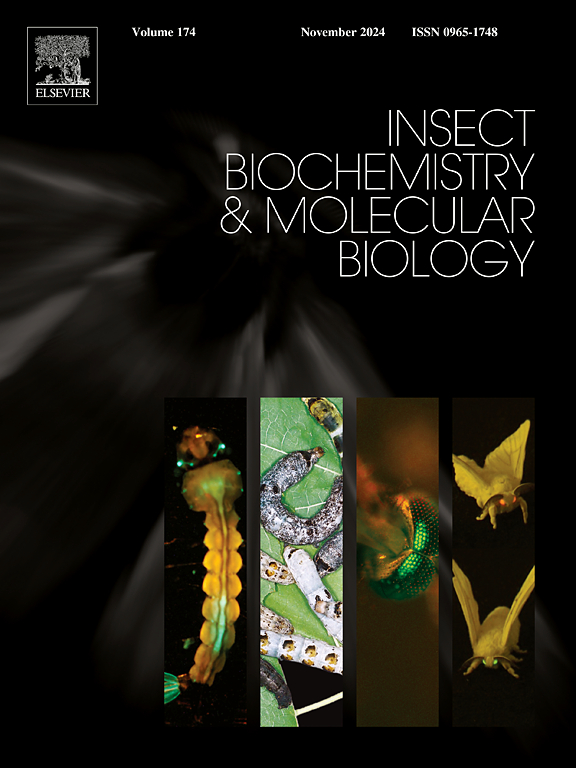A CRISPR/Cas9-induced point mutation on the GABA receptor subunit RDL confers high resistance to phenylpyrazole insecticides in the rice planthopper Laodelphax striatellus
IF 3.7
2区 农林科学
Q2 BIOCHEMISTRY & MOLECULAR BIOLOGY
引用次数: 0
Abstract
The Delphacidae planthopper Laodelphax striatellus (Order: Hemiptera) is one of the most damaging insect pests of rice crops in Asia. The phenylpyrazole insecticide fipronil was introduced in China in the mid-1990s to control these pests, but its widespread use has led to the development of high levels of resistance. Field sampling coupled with in vitro assays indicated that an A2′N-point mutation in the gamma-aminobutyric acid receptor RDL has been linked to fipronil resistance; however, genetic evidence supporting this association has been lacking. Here, we generated an A2′N-point mutation (LsRDLA/N) in L. striatellus using CRISPR/Cas9-mediated homologous recombination. Bioassay revealed that the LsRDLA/N mutants conferred a 1211-fold higher resistance to fipronil compared to wild-type planthoppers. Furthermore, these mutants also showed significant resistance (>1000-fold) to ethiprole but not to imidacloprid, demonstrating that the A2′N mutation confers resistance specific to phenylpyrazole insecticides. However, the LsRDLA/N mutants displayed reduced fecundity, lower egg hatching rates, and prolonged egg and nymph stages, indicating that fipronil resistance carries a substantial fitness cost. These findings enhance our understanding of the genetic mechanisms underlying phenylpyrazole resistance and provide valuable insights for developing effective resistance management strategies for planthoppers.

CRISPR/ cas9诱导的GABA受体亚基RDL点突变使稻褐飞虱对苯吡唑类杀虫剂具有高抗性
褐飞虱科褐飞虱(半翅目)是亚洲地区危害最严重的水稻害虫之一。20世纪90年代中期,中国引进了苯吡唑类杀虫剂氟虫腈,以控制这些害虫,但它的广泛使用导致了高度抗药性的发展。现场取样和体外试验表明,γ -氨基丁酸受体RDL的a2′n点突变与氟虫腈耐药性有关;然而,支持这种关联的遗传证据一直缺乏。在这里,我们利用CRISPR/ cas9介导的同源重组在纹状乳杆菌中产生了a2 ' N点突变(LsRDLA/N)。生物测定显示,LsRDLA/N突变体对氟虫腈的抗性比野生型飞虱高1211倍。此外,这些突变体对乙虫腈也表现出显著的抗性(1000倍),但对吡虫啉却没有,这表明a2n突变对苯吡唑类杀虫剂具有特异性抗性。然而,LsRDLA/N突变体表现出较低的繁殖力,较低的卵孵化率,以及较长的卵和若虫期,表明氟虫腈抗性带来了巨大的适应成本。这些发现增强了我们对苯吡唑抗性遗传机制的理解,并为制定有效的抗性管理策略提供了有价值的见解。
本文章由计算机程序翻译,如有差异,请以英文原文为准。
求助全文
约1分钟内获得全文
求助全文
来源期刊
CiteScore
7.40
自引率
5.30%
发文量
105
审稿时长
40 days
期刊介绍:
This international journal publishes original contributions and mini-reviews in the fields of insect biochemistry and insect molecular biology. Main areas of interest are neurochemistry, hormone and pheromone biochemistry, enzymes and metabolism, hormone action and gene regulation, gene characterization and structure, pharmacology, immunology and cell and tissue culture. Papers on the biochemistry and molecular biology of other groups of arthropods are published if of general interest to the readership. Technique papers will be considered for publication if they significantly advance the field of insect biochemistry and molecular biology in the opinion of the Editors and Editorial Board.

 求助内容:
求助内容: 应助结果提醒方式:
应助结果提醒方式:


